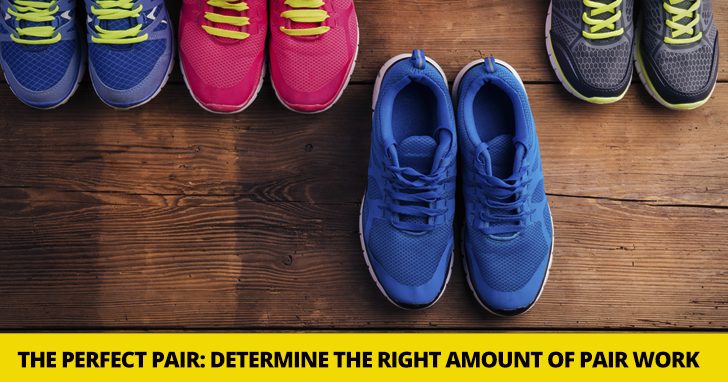Pair Work vs. Group Work: What's Better For The Learner?


How do you know how much pair work is right for your students? How can you tell if you are doing too much or too little work one on one? In reality, the perfect amount of pair work for each class will be a little bit different. It depends on the individuals who make up your class, their personalities, and their goals for language learning. But there are some ways to know if you are getting close to that magic number no matter who you are teaching. Here are some factors to consider as you look to achieve that perfect number for face to face work.
The best English classes offer a balance between pair work and other types of work: group work, team games, independent work, whole class activities, teacher led activities, and student led activities. Survey the activities you have planned for class and see just what percentage of those are one on one activities. You should be averaging around the same percentage for each type of activity. If your pair work percentage is much higher or much lower than the rest of your percentages, it’s time to change things up. Reduce the activities your students do with a partner or increase them to keep your percentages in approximately the same place.
Another sign of too much or too little pair work is how long it takes you to go through each unit. If it is taking you too long to go through each unit you might have too much pair work planned, or if you are breezing through each unit too quickly, you might need to add some. Less pair work will help you complete units faster, and more pair work will lengthen the amount of time you spend on a given unit. Vary the amount of time your students spend working with a partner to either increase or decrease the amount of time you spend on a given unit.
The students making up your class can have a big influence on how much pair work is the right amount. If you are teaching a mixed level class, you may find more advanced students complaining about the amount of time they are working with students at a lower level. If this is the case, you may need to reduce the amount of pair work you do. If students feel like they do not know each other at all, you probably aren’t doing enough pair work.
You might also consider how you pair your students if you are getting any complaints about pair work. Rather than pairing more advanced students with lower level students all of the time, have more advanced students work with each other and spur one another on to linguistic greatness and let your lower level students help each other as they learn.
The point of language is to be communicative. To talk to other people. To share ideas through language. Your students can’t do this if you are the only one talking all of the time. One on one work increases the amount of time your students talk and decreases the amount of time you, the teacher, talk. Your goal should be to keep their talk time much higher than yours. If you spend as much time talking in class as your students do, you may want to increase the amount of pair work they are doing so that their talk time supersedes your own.
Though it may sound counterintuitive, if your students are very comfortable with pair work you may be doing too much of it. If on the other hand, they have absolutely no idea how to work with a partner, you may be doing too little pair work. Use your students’ actions as a way to measure whether or not you are hitting the mark. If your students automatically move into pairs when you start a new activity, it may be time to cut down on pair work. If on the other hand they are completely lost when you do an activity with a partner, you may have to increases their pair work, but do it slowly. You don’t want to overwhelm your students and scare them off of partner work completely. Ease them in and they will have a much better long term attitude toward working with another classmate.
It is important that you as the teacher know why you are doing pair work with your students. Because the book tells you to isn’t enough of a reason. What are your goals for each pair work activity? Do you want students to talk more? Do you want them to self-correct before you offer corrections? Until you know why you are doing pair work you will never know whether that pair work is effective.
Once you know the reasons you are doing pair work, communicate those reasons to your students. When they know the goal or the purpose behind partner activities, they will work toward that goal with you rather than drifting away from it.
Additionally, think about activities that people naturally do in pairs. It’s not very typical for two people to write together for, say, a personal letter. However, people often work with a partner to create brochures. Include pair work when it would be natural for the language goal, and keep it to a minimum for activities that wouldn’t normally be done in pairs in the real world.
Culture is always coming up in ESL classes. Perhaps it is because culture is such a huge part of our expectations and values and at the same time is so very hard to pinpoint. Culture is such a big part of our makeup that we can’t help but assume everyone else holds those same values and customs as well. Because of this, you might not realize when cultural expectations and influences come into play with pair work. There can be cultural expectations that make pair work unacceptable or at least undesirable. There can be other cultural expectations that affect how students communicate with each other when they are in pairs. Be aware of the specific cultural issues that come into play in your classroom, and choose your one on one time accordingly.
What do your students think about the amount of time you spend working in pairs? Their opinion isn’t necessarily the right one, but it can be a good indicator of whether you are spending too much or too little time with a partner. Ask your students about the amount of time they work with classmates as well as the types of activities they do during that pair work time. Then take their opinions into consideration when you determine whether you are hitting the right balance between pair work and other types of classroom work.
The perfect amount of time for pair work in class might not be something you can pinpoint or define with an exact number. However, you can draw nearer and nearer to it if you take the time to think about what you are doing and why you are doing it. Evaluate, on a regular basis, how much time you spend working in pairs during class and you will surely move toward that perfect number even if you cannot numerate exactly what it is.